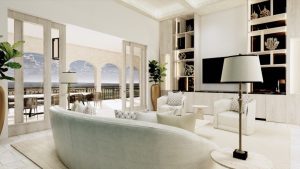Your home is more than just a collection of rooms; it’s a reflection of your personality, a haven for relaxation, and a stage for creating memories. But sometimes, translating your vision of that perfect space into reality can feel overwhelming. This is where home interior design comes in.
What is Home Interior Design?
The art and science of improving a space’s interior to provide a practical, visually beautiful, and healthy atmosphere is known as home interior design. It encompasses a wide range of elements, from spatial planning and furniture selection to color schemes, lighting, and decorative accents.
The Elements of Interior Design
A successful interior design project considers several key elements working in harmony:
Space Planning:
This involves maximizing the functionality of your space. It considers traffic flow, furniture placement, designated areas for specific activities, and storage solutions.
Line:
Lines define the structure and form of a space. This can be through architectural details, furniture silhouettes, or even decorative patterns.
Texture:
Textures add visual and tactile interest to a room. Consider the textures of your walls, flooring, furniture fabrics, and artwork.
Pattern:
Patterns can create visual interest, add personality, and even influence the perceived size of a space.

Color:
Color is a powerful tool that sets the mood and tone of a room. Explore cool colors for a calming effect or warm colors for a more energetic feel.
Light:
Lighting plays a crucial role in both functionality and ambiance. Utilize natural light and incorporate various types of artificial lighting to create layers and highlight specific areas.
Form:
This refers to the three-dimensional shapes of furniture and objects within the space. Consider the balance between geometric and organic forms.
Finding Your Style
Before diving into specific design choices, it’s important to identify your style. Flip through interior design magazines, browse online inspiration boards (like Pinterest), and consider spaces that resonate with you. To help you get started, here are a few popular styles:
Modern:
Clean lines, minimalist furniture, and a focus on functionality define modern design. Neutral color palettes and pops of color through artwork or statement pieces are common.
Mid-Century Modern:
This iconic style reflects the design aesthetic of the 1950s and 1960s. Think clean lines, organic shapes, and pops of bold color.
Rustic:
This style evokes a feeling of warmth and comfort. Think natural materials like wood and stone, exposed beams, and a muted color palette.
Bohemian:
Embrace a relaxed and eclectic aesthetic with the bohemian style. Layered textiles, vintage finds, and a mix of patterns are key elements.
Keep in mind that your style doesn’t have to neatly fall into one category. It’s all about creating a space that reflects your unique personality and taste.
Bringing Your Vision to Life
Once you have a handle on the elements of design and your preferred style, you can start putting your plan into action:
Measure and create a floor plan:
This will help you visualize furniture placement and ensure everything fits comfortably within the space.
Set a budget:
Determine how much you’re comfortable spending on furniture, decor, and renovations.
Start with key pieces:
Invest in quality furniture pieces that will form the foundation of your design.
Layer in lighting:
Utilize natural light and incorporate a mix of ambient, task, and accent lighting to create a balanced and inviting atmosphere.
Accessorize thoughtfully:
Don’t overwhelm your space with clutter. Select a few statement pieces that complement your chosen style.
Don’t be afraid to DIY:
Numerous DIY projects can personalize your space and add a touch of creativity.
Seeking Professional Help
If you feel overwhelmed by the design process, consider hiring an interior designer. A professional can help you:
Develop a cohesive design plan:
An interior designer can translate your vision into a reality that considers functionality, aesthetics, and your budget.
Source furniture and materials:
They can help you find high-quality pieces that fit your style and budget.
Navigate space planning challenges:
If you have a unique layout or limited square footage, a designer can help you maximize the space.
The Final Touch
Home interior design is a journey of self-expression and creating a space that reflects your personality. Don’t be afraid to experiment, have fun, and let your creativity flow. Remember, the most important element is that your home feels comfortable, attractive, and authentic.